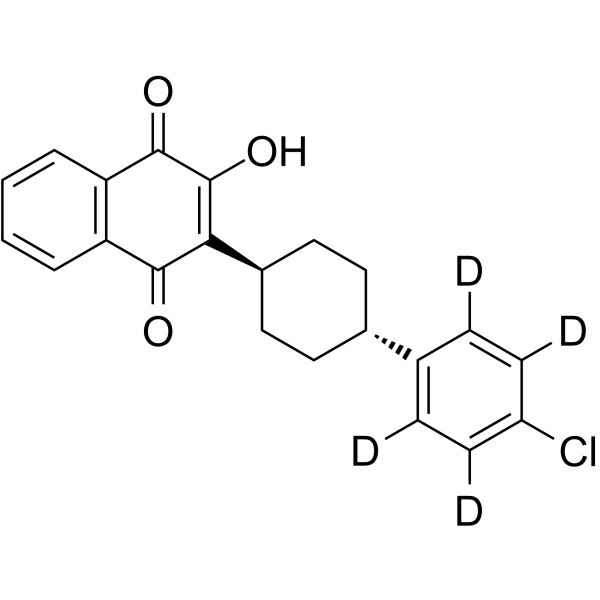Atovaquone (4-chlorophenyl-2,3,5,6-d4)
Modify Date: 2024-01-20 21:41:38

Atovaquone (4-chlorophenyl-2,3,5,6-d4) structure
|
Common Name | Atovaquone (4-chlorophenyl-2,3,5,6-d4) | ||
|---|---|---|---|---|
| CAS Number | 1163294-17-4 | Molecular Weight | 370.86 | |
| Density | N/A | Boiling Point | N/A | |
| Molecular Formula | C22H15D4ClO3 | Melting Point | N/A | |
| MSDS | N/A | Flash Point | N/A | |
Use of Atovaquone (4-chlorophenyl-2,3,5,6-d4)Atovaquone (4-chlorophenyl-2,3,5,6-d4) is the deuterium labeled Atovaquone. Atovaquone is a potent, selective and orally active inhibitor of the parasite’s mitochondrial cytochrome bc1 complex. Atovaquone is against human and P. falciparum cytochrome bc1 activity with IC50 values of 460 nM and 2.0 nM, respectively. Atovaquone is an antimalarial agent and has the potential for the investigation of neumocystis pneumonia, toxoplasmosis, malaria, and babesia[1][2]. |
| Name | Atovaquone (4-chlorophenyl-2,3,5,6-d4) |
|---|
| Description | Atovaquone (4-chlorophenyl-2,3,5,6-d4) is the deuterium labeled Atovaquone. Atovaquone is a potent, selective and orally active inhibitor of the parasite’s mitochondrial cytochrome bc1 complex. Atovaquone is against human and P. falciparum cytochrome bc1 activity with IC50 values of 460 nM and 2.0 nM, respectively. Atovaquone is an antimalarial agent and has the potential for the investigation of neumocystis pneumonia, toxoplasmosis, malaria, and babesia[1][2]. |
|---|---|
| Related Catalog | |
| In Vitro | Stable heavy isotopes of hydrogen, carbon, and other elements have been incorporated into drug molecules, largely as tracers for quantitation during the drug development process. Deuteration has gained attention because of its potential to affect the pharmacokinetic and metabolic profiles of drugs[1]. |
| References |
| Molecular Formula | C22H15D4ClO3 |
|---|---|
| Molecular Weight | 370.86 |